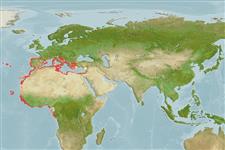Common names from other countries
>
Kurtiformes (Nurseryfishes, cardinalfishes.) >
Apogonidae (Cardinalfishes) > Apogoninae
Etymology: Apogon: Greek, a = without + Greek pogon = chin, beard (Ref. 45335).
More on author: Linnaeus.
Environment: milieu / climate zone / depth range / distribution range
Ecologie
marien rifbewoner; standvastig; diepte 10 - 200 m (Ref. 4738). Subtropical; 45°N - 5°S, 32°W - 36°E
Eastern Atlantic and Mediterranean Sea: Portugal to Morocco and the Azores. Elsewhere, southward to Gulf of Guinea.
Grootte / Gewicht / Leeftijd
Maturity: Lm ? range ? - 5.5 cm
Max length : 15.0 cm SL mannelijk / geslacht onbekend; (Ref. 4738); max. gerapporteerde leeftijd: 5 Jaren (Ref. 93355)
Dorsale stekels (totaal): 7; Dorsale zachte stralen (totaal): 9-10; Anale stekels 2; Anale zachte stralen: 8 - 9. Eye very large, much greater than snout. Pectoral fin long, reaching at least origin of anal fin. Preopercular edge only slightly serrated, preopercular ridge smooth. Body and fins red or pink, back and upper surface of head dusky. Two or three dark spots, sometimes joined, along base of caudal fin.
Occasionally forms schools; sometimes solitary. Inhabits muddy or rocky bottoms and caves (Ref. 4738). A sciaphilous species thriving in a number of shady/dark habitats and frequents marine caves, where it forms large schools (Ref. 118281). Feeds on small invertebrates and fishes (Ref. 4738). Observed to feed in the water column and just over the bottom, always at night; 93.4% of observed events occurring outside the caves, usually on rocky bottoms and Posidonia oceanica meadows, and to a lesser extent on pebbles (Ref. 118281). Oral brooding by males (Ref. 4738).
Males incubate eggs in buccal cavity (Ref. 205, 4738, 74407). Embryos do not feed externally in the buccal cavity. Distinct pairing during courtship and spawning (Ref. 205). Internal fertilization and paternal care by mouthbrooding is found to be a rare combination of reproductive strategy (Ref. 74407). Also Ref. 240.
Tortonese, E., 1986. Apogonidae. p. 803-809. In P.J.P. Whitehead, M.-L. Bauchot, J.-C. Hureau, J. Nielsen and E. Tortonese (eds.) Fishes of the north-eastern Atlantic and the Mediterranean. UNESCO, Paris. vol. 2. (Ref. 4738)
Status op de Rode Lijst van het IUCN (Ref. 130435)
CITES (Ref. 128078)
Not Evaluated
Gevaar voor de mens
Harmless
Gebruik door de mens
Aas:
Meer informatie
ReferentiesAquacultuurAquacultuurprofielKweeklijnenGeneticaElectrophoresesErfelijkheidZiektesVerwerkingMassaconversie
Tools
Speciale rapporten
Download XML
Internetbronnen
Estimates based on models
Preferred temperature (Ref.
115969): 13.3 - 20.9, mean 16.3 (based on 216 cells).
Fylogenetische diversiteitsindex (Ref.
82804): PD
50 = 0.5000 [Uniqueness, from 0.5 = low to 2.0 = high].
Bayesian length-weight: a=0.01096 (0.00658 - 0.01826), b=3.11 (2.97 - 3.25), in cm Total Length, based on LWR estimates for this species & Genus-body shape (Ref.
93245).
Trofisch niveau (Ref.
69278): 3.4 ±0.61 se; based on food items.
Weerstandsvermogen (Ref.
120179): Gemiddeld, minimale populatieverdubbelingstijd 1,4-4,4 jaar (K=0.90; tmax=5).
Fishing Vulnerability (Ref.
59153): Low vulnerability (15 of 100).
